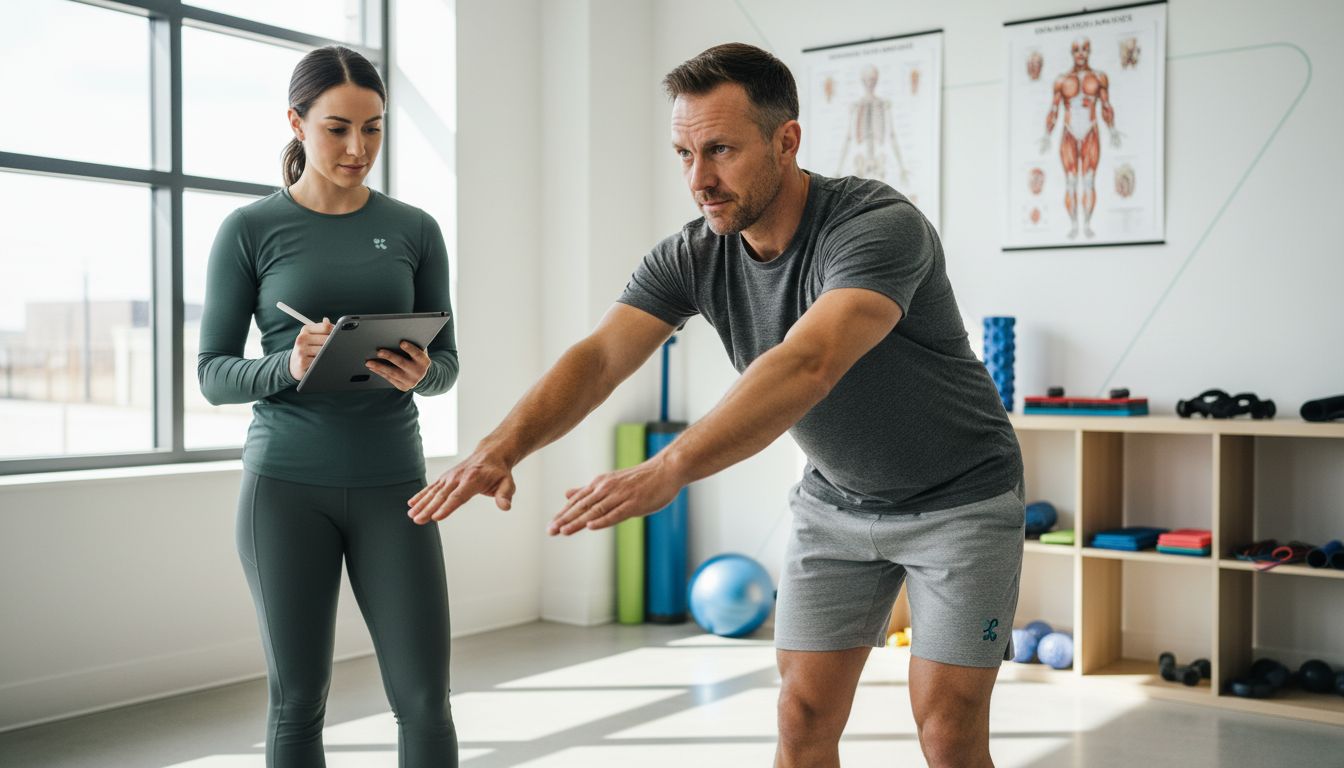Pain Management Techniques Guide for Active Lifestyles
- Dr Nathan Bridger

- 10 minutes ago
- 7 min read

Over 60 percent of active adults experience persistent aches that interfere with daily movement. When pain disrupts your workouts or simple routines, it can feel frustrating and confusing. Understanding and improving your pain and movement patterns is key to getting back on track. With the right strategies, you can pinpoint what aggravates your discomfort and take clear steps to restore comfort, mobility, and long-term physical health.
Table of Contents
Quick Summary
Key Point | Explanation |
1. Assess pain and movement patterns | Begin with a self evaluation to identify pain locations and potential restrictions during movements. |
2. Identify daily habits causing pain | Conduct an audit of your daily activities and routines to find habits that exacerbate discomfort. |
3. Implement personalised self-care routines | Create a customised plan incorporating stretching and mobility exercises targeting your pain points. |
4. Develop proactive strength strategies | Focus on a balanced strength training program that enhances overall body mechanics and resilience. |
5. Regularly evaluate and adjust strategies | Keep a detailed pain journal to track improvements and modify your approach as necessary. |
Step 1: Assess your current pain and movement patterns
Evaluating your current pain and movement patterns is crucial for developing an effective pain management strategy for active lifestyles. According to PainHEALTH, understanding how pain impacts your movement is the first step towards recovery and improved mobility.
To accurately assess your pain and movement, start by performing a comprehensive self evaluation. Begin with a body scan where you move slowly through different ranges of motion and note any areas of discomfort or restriction. Pay close attention to how pain changes during specific movements like bending, twisting, reaching, or walking. Document the location of pain, its intensity (on a scale of 1 to 10), and what activities trigger or worsen the discomfort.
A key insight from Royal Children’s Hospital suggests tracking pain patterns over time. Consider keeping a pain journal where you record daily pain levels, associated activities, and any factors that seem to influence your symptoms. This detailed tracking will help healthcare professionals develop a more precise understanding of your specific movement challenges and pain triggers.
For athletes and active individuals, understanding these movement patterns is not about limitation but strategic adaptation. Your goal is to identify compensatory movements that might be causing additional stress on your body and develop targeted strategies to restore balanced, pain free motion.
Step 2: Identify daily habits that contribute to pain
Understanding the daily habits that might be causing or exacerbating your pain is a critical step in developing an effective pain management strategy. Painaustralia highlights that many chronic pain experiences are deeply connected to our everyday routines and lifestyle choices.
Begin by conducting a comprehensive audit of your daily activities. Note your typical postures during work, especially if you spend extended periods sitting at a desk or performing repetitive tasks. According to Musculoskeletal Australia, poor ergonomics and sustained postures can significantly contribute to musculoskeletal pain. Pay attention to how you sit, stand, lift objects, and sleep. Look for patterns like hunching over your computer, carrying heavy bags on one side, or sleeping in positions that strain your neck and back.
Additionally, track your physical activities and exercise routines. Are you pushing too hard without adequate recovery? Are your workout techniques causing unnecessary strain? Sometimes, well intentioned fitness efforts can inadvertently create biomechanical stress. By meticulously documenting these habits, you can start identifying potential pain triggers and develop targeted strategies to modify your daily movements for better overall comfort and performance.

For athletes and active individuals, understanding these subtle daily habits is not about restriction but about strategic optimization. By making small adjustments to your routine, you can significantly reduce pain risk and enhance your body’s resilience.
Step 3: Implement targeted self-care and mobility routines
Developing a personalised self-care and mobility routine is essential for managing pain and maintaining optimal physical performance. PainHEALTH emphasises that strategic mobility exercises can significantly improve your body’s resilience and reduce pain sensitivity.
Start by creating a comprehensive routine that includes gentle stretching, controlled mobility exercises, and targeted strength work. According to Musculoskeletal Australia, effective self-care routines should focus on improving range of motion, building muscular support around vulnerable areas, and promoting balanced movement patterns. Begin with low intensity movements that match your current pain levels, gradually increasing complexity and duration as your body adapts.
Key elements of an effective self-care routine include dynamic warm ups, specific mobility drills targeting problem areas, controlled strength exercises, and active recovery techniques. For active individuals, this might mean incorporating foam rolling, gentle yoga flows, resistance band work, and mindful movement practices that help reset your body’s movement patterns. Remember that consistency is more important than intensity. Short daily sessions are far more beneficial than sporadic intense workouts.
Your goal is to transform self-care from a reactive approach to a proactive lifestyle strategy. By dedicating time to understanding and nurturing your body’s needs, you can build a robust foundation for long term physical resilience and pain free performance.
Step 4: Utilise proactive strength and conditioning strategies
Strength and conditioning are fundamental approaches to managing pain and preventing future musculoskeletal issues for active individuals. Painaustralia emphasises that proactive exercise regimens play a critical role in maintaining overall musculoskeletal health and reducing chronic pain experiences.
Begin by developing a comprehensive strength training program that focuses on functional movement patterns and balanced muscle development. Physiomates recommends targeting core stability, joint mobility, and movement efficiency rather than simply lifting heavy weights. This means incorporating exercises that challenge your body’s ability to maintain proper alignment and control during complex movements. Start with bodyweight exercises, progressively adding resistance as your technique and strength improve.
Your strength and conditioning strategy should include a mix of mobility work, stability training, and progressive resistance exercises. Focus on movements that improve overall body mechanics such as squats, lunges, planks, and controlled rotational exercises. Pay special attention to addressing muscle imbalances and strengthening supporting muscle groups around previously injured or pain sensitive areas. The key is to build a resilient body that can handle varied physical demands while minimising injury risk.
Remember that effective strength and conditioning is about intelligent, consistent progression. Your goal is to create a sustainable approach to fitness that supports your body’s long term health and performance potential.
Step 5: Evaluate progress and adjust your approach
Periodically assessing your pain management journey is crucial for sustained improvement and long term success. Royal Children’s Hospital emphasises the importance of systematic progress tracking to ensure your strategies remain effective and responsive to your body’s changing needs.
Implement a structured assessment process using comprehensive pain evaluation tools. According to Agency for Clinical Innovation, this involves regularly documenting pain intensity, frequency, duration, and impact on daily activities. Create a detailed pain journal that tracks not just pain levels but also your mobility, strength improvements, and overall functional capacity. Look for trends such as reduced pain during specific movements, increased range of motion, or improvements in your ability to perform daily tasks.
Be prepared to make informed adjustments to your pain management strategy. This might mean modifying your exercise routine, exploring additional recovery techniques, or consulting healthcare professionals if you are not seeing the desired progress. Remember that pain management is a dynamic process where flexibility and consistent monitoring are key. Your approach should evolve as your body adapts, always with the goal of improving your overall physical resilience and quality of life.

The most successful pain management strategies are those that remain responsive and personalised to your unique physiological needs and lifestyle demands.
Take Control of Your Pain and Move with Confidence Today
Managing pain while staying active can feel overwhelming when the source of discomfort and movement challenges are unclear. This guide highlights how critical it is to assess your pain patterns, adjust daily habits, and commit to targeted self-care and strength routines that build resilience rather than simply mask pain. If you are ready to stop letting pain dictate your day and want a personalised plan designed around real-world movement and lasting results, expert support is within reach.

At North Fremantle Chiropractic, we understand what it takes to move beyond pain back into doing what you love. Our hands-on, active approach combines elite sports-focused chiropractic care with strength and conditioning strategies tailored for your unique body and lifestyle. Whether you are juggling family life training on weekends or striving for peak performance, our team helps you build true physical resilience and balanced movement to drastically reduce pain risks and enhance performance. Don’t wait for pain to worsen. Explore what a tailored pain management and movement plan can do for you today and experience care that feels like progress not just treatment.
Frequently Asked Questions
How can I assess my current pain and movement patterns?
Begin by performing a self-evaluation that includes a body scan to identify areas of discomfort or restriction during various movements. Document pain locations and intensities on a scale of 1 to 10, noting what activities trigger discomfort, to help create a tailored pain management plan.
What daily habits might be contributing to my pain during physical activities?
Conduct a thorough audit of your daily routines, focusing on postures while sitting, standing, and lifting. Identify any repetitive movements or poor ergonomic practices, and modify them to prevent exacerbating your pain and enhance overall comfort.
How do I create a personalized self-care and mobility routine for pain management?
Develop a routine that includes gentle stretching, mobility exercises, and strength training tailored to your current pain levels. Start with low-intensity movements and gradually increase complexity, aiming for short daily sessions to promote long-term resilience.
What strength and conditioning strategies can I use to manage pain and prevent injuries?
Create a strength training program that focuses on functional movements, core stability, and muscle balance. Incorporate exercises like squats and lunges while progressively adding resistance, ensuring you address muscle imbalances to minimise injury risk.
How can I evaluate my progress in managing pain?
Implement a structured process to regularly document pain intensity, frequency, and impact on daily activities in a detailed pain journal. Evaluate trends over time to adjust your pain management strategies accordingly, ensuring you focus on improvements in mobility and overall function.
When should I consider adjusting my pain management approach?
Reassess your strategies if you notice no improvement after consistent efforts over a few weeks. Adapt your routine or seek professional guidance if necessary to ensure your pain management evolves in response to your body’s changing needs.
Recommended

Comments